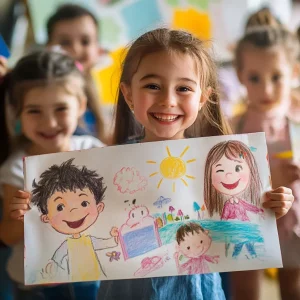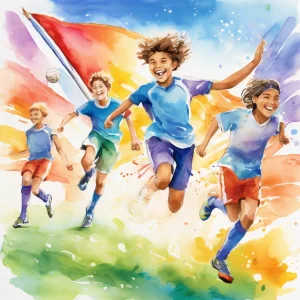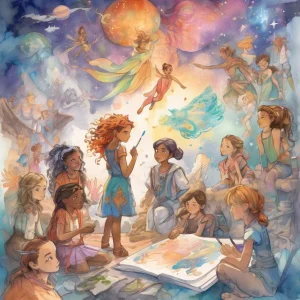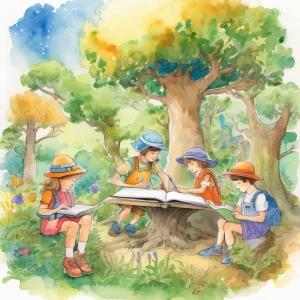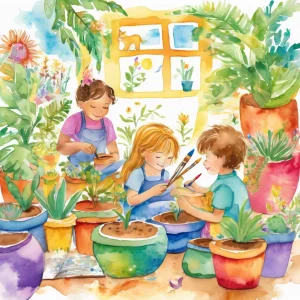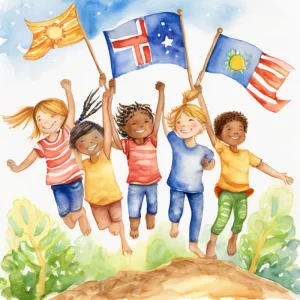Activity
Similar Activities
Harmony of Colors: Collaborative Finger Painting Masterpiece
Children’s Age: 2–3 years
Activity Duration: 15 minutes
Engage children aged 24 to 36 months in the "Collaborative Finger Painting Masterpiece" activity to foster empathy, cooperation, and creativity. Set up with paper, colorful non-tox…
Activity Duration: 15 minutes
Cosmic Conundrum Chefs: Space Word Problem Adventure
Children’s Age: 7–8 years
Activity Duration: 10 – 20 minutes
Let's play Space Word Problem Chefs! We'll use paper, pencils, and space-themed stickers to explore language and problem-solving. Set up a cozy spot, grab your supplies, and get re…
Activity Duration: 10 – 20 minutes
Empathy Tales: The Storybook Creation Adventure
Children’s Age: 2–12 years
Activity Duration: 10 – 15 minutes
This activity helps children aged 2 to 6 develop empathy by creating a personalized storybook. You will need paper, crayons, stickers, scissors, glue, and story prompts like "A Day…
Activity Duration: 10 – 15 minutes
Magical Storytelling: Create Together with Friends
Children’s Age: 4–6 years
Activity Duration: 15 – 30 minutes
In the Create a Story Together activity, children will explore their creativity, language skills, and teamwork. Get small pieces of paper, colored pencils, and a container ready. K…
Activity Duration: 15 – 30 minutes
Empathy Through Sports: Team Building Sports Challenge
Children’s Age: 11–15 years
Activity Duration: 1 hour
The "Team Building Sports Challenge" is ideal for kids aged 11 to 15, promoting empathy through sports and teamwork. With sports equipment, paper, and markers, set up stations and …
Activity Duration: 1 hour
Magical Melodies: Sensory Sound Exploration
Children’s Age: 3 – 9 months
Activity Duration: 5 – 10 minutes
Engage infants aged 3 to 9 months in the Sensory Sound Exploration activity to boost communication, cognitive, and language skills through sensory play. Set up a safe play area wit…
Activity Duration: 5 – 10 minutes
Enchanted Storybook Illustration Adventure
Children’s Age: 6–10 years
Activity Duration: 25 minutes
Engage children aged 6 to 10 in the "Storybook Illustration Adventure" for a creative and language-rich experience. Gather drawing materials and set up individual workspaces to ill…
Activity Duration: 25 minutes
Whispers of Nature: Eco-Puzzle Challenge
Children’s Age: 8–12 years
Activity Duration: 20 minutes
The "Eco-Puzzle Challenge" activity is a fun and educational way to promote empathy, play skills, and ecological awareness in children aged 8 to 12. Children work in small teams to…
Activity Duration: 20 minutes
Enchanted Quest: The Technological Treasure Hunt
Children’s Age: 10–12 years
Activity Duration: 20 – 40 minutes
Embark on the Technological Treasure Hunt for an exciting outdoor adventure that boosts cognitive and language skills in children. Hide clues and tech items in outdoor spots, leadi…
Activity Duration: 20 – 40 minutes
Animal-Inspired Plant Pots: Creative Nature Creations
Children’s Age: 3–6 years
Activity Duration: 20 minutes
Children will have a blast making animal-inspired plant pots, sparking creativity while learning about nature. Gather supplies like paint, pots, seeds, and soil to set up a creativ…
Activity Duration: 20 minutes
Empathy Journey: Cultural Balance Relay Race Adventure
Children’s Age: 6–9 years
Activity Duration: 25 – 30 minutes
The Cultural Balance Relay Race activity encourages empathy, teamwork, and cultural understanding in children. Set up the course with flags, cones, ecosystem visuals, and music for…
Activity Duration: 25 – 30 minutes
Enchanted Nature-Based Storytelling Adventure
Children’s Age: 0 month – 6 years
Activity Duration: 5 – 10 minutes
Let's have fun with Nature-Based Storytelling! Find a cozy outdoor spot, lay down a blanket, and bring a basket for collecting leaves and stones. Sit with your child, explore natur…
Activity Duration: 5 – 10 minutes







